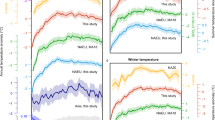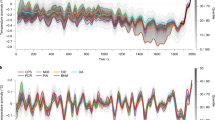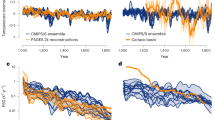Abstract
Comparing simulations of key warm periods in Earth history with contemporaneous geological proxy data is a useful approach for evaluating the ability of climate models to simulate warm, high-CO2 climates that are unprecedented in the more recent past1,2,3. Here we use a global data set of confidence-assessed, proxy-based temperature estimates and biome reconstructions to assess the ability of eight models to simulate warm terrestrial climates of the Pliocene epoch. The Late Pliocene, 3.6–2.6 million years ago, is an accessible geological interval to understand climate processes of a warmer world4. We show that model-predicted surface air temperatures reveal a substantial cold bias in the Northern Hemisphere. Particularly strong data–model mismatches in mean annual temperatures (up to 18 °C) exist in northern Russia. Our model sensitivity tests identify insufficient temporal constraints hampering the accurate configuration of model boundary conditions as an important factor impacting on data–model discrepancies. We conclude that to allow a more robust evaluation of the ability of present climate models to predict warm climates, future Pliocene data–model comparison studies should focus on orbitally defined time slices5.
This is a preview of subscription content, access via your institution
Access options
Subscribe to this journal
Receive 12 print issues and online access
$209.00 per year
only $17.42 per issue
Buy this article
- Purchase on Springer Link
- Instant access to full article PDF
Prices may be subject to local taxes which are calculated during checkout



Similar content being viewed by others
References
Masson-Delmotte, V. et al. Past and future polar amplification of climate change: Climate model intercomparisons and ice-core constraints. Clim. Dynam. 26, 513–529 (2006).
Salzmann, U., Haywood, A. M., Lunt, D. J., Valdes, P. J. & Hill, D. J. A new global biome reconstruction and data–model comparison for the Middle Pliocene. Glob. Ecol. Biogeogr. 17, 432–447 (2008).
Shellito, C. J., Lamarque, J-F. & Sloan, L. C. Early Eocene Arctic climate sensitivity to p CO 2 and basin geography. Geophys. Res. Lett. 36, L09707 (2009).
Jansen, E. et al. in IPCC Climate Change 2007: The Physical Science Basis (eds Solomon, S. et al.) 433–497 (Cambridge Univ. Press, 2007).
Haywood, A. M. et al. On the identification of a Pliocene time slice for data–model comparison. Phil. Trans. R. Soc. A http://dx.doi.org/10.1098/rsta.2012.0515 (2013).
Randall, D. A. et al. in IPCC Climate Change 2007: The Physical Science Basis (eds Solomon, S. et al.) 589–662 (Cambridge Univ. Press, 2007).
Huber, M. & Caballero, R. The early Eocene equable climate problem revisited. Clim. Past 7, 603–633 (2011).
Bijl, P. K. et al. Early Palaeogene temperature evolution of the southwest Pacific Ocean. Nature 461, 776–779 (2009).
Pagani, M., Liu, Z., LaRiviere, J. & Ravelo, A. C. High Earth-system climate sensitivity determined from Pliocene carbon dioxide concentrations. Nature Geosci. 3, 27–30 (2010).
Prentice, I. C. et al. A global biome model based on plant physiology and dominance, soil properties and climate. J. Biogeogr. 19, 117–134 (1992).
Kaplan, J. O. et al. Climate change and arctic ecosystems II: Modeling, paleodata–model comparisons, and future projections. J. Geophys. Res. Atmos. 108, 8171 (2003).
Hansen, J. et al. in Climate Processes and Climate Sensitivity (eds Hansen, J. E. & Takahashi, T.) 130–163 (American Geophysical Union, 1984).
Mastrandrea, M. D. et al. IPCC Guidance Note for Lead Authors of the IPCC Fifth Assessment Report on Consistent Treatment of Uncertainties. (IPCC, 2010); https://www.ipcc-wg1.unibe.ch/guidancepaper/ar5_uncertainty-guidance-note.pdf.
McKay, R. et al. Antarctic and Southern Ocean influences on Late Pliocene global cooling. Proc. Natl Acad. Sci. USA 109, 6423–6428 (2012).
Dowsett, H. J. et al. Assessing confidence in Pliocene sea surfacetemperatures to evaluate predictive models. Nature Clim. Change 2, 365–371 (2012).
Haywood, A. M. et al. Pliocene Model Intercomparison Project (PlioMIP): Experimental design and boundary conditions (Experiment 2). Geosci. Model Dev. 4, 571–577 (2011).
Dowsett, H. et al. The PRISM3D paleoenvironmental reconstruction. Stratigraphy 7, 123–139 (2010).
Dowsett, H. J. et al. Middle Pliocene Paleoenvironmental Reconstruction: PRISM2 Open File Report 99–535 (USGS, 1999).
Lunt, D. J. et al. On the causes of mid-Pliocene warmth and polar amplification. Earth Planet. Sci. Lett. 321–322, 128–138 (2012).
Lunt, D. J., Foster, G. L., Haywood, A. M. & Stone, E. J. Late Pliocene Greenland glaciation controlled by a decline in atmospheric CO2 levels. Nature 454, 1102–1106 (2008).
Lisiecki, L. E. & Raymo, M. E. A Pliocene–Pleistocene stack of globally distributed benthic 18O records. Paleoceanography 20, PA1003 (2005).
Mosbrugger, V. & Utescher, T. The coexistence approach—a method for quantitative reconstructions of Tertiary terrestrial palaeoclimate data using plant fossils. Paleogeogr. Palaeoclimatol. Palaeoecol. 134, 61–86 (1997).
Utescher, T. & Mosbrugger, V. Palaeoflora Database (2010); available at http://www.palaeoflora.de.
Salzmann, U., Haywood, A. M. & Lunt, D. J. The past is a guide to the future? Comparing Middle Pliocene vegetation with predicted biome distributions for the twenty-first century. Phil. Trans. R. Soc. A 367, 189–204 (2009).
Cohen, J. A coefficient of agreement for nominal scales. Educ. Psychol. Meas. 2, 37–46 (1960).
Harrison, S. P. & Prentice, I. C. Climate and CO2 controls on global vegetation distribution at the last glacial maximum: Analysis based on palaeovegetation data, biome modelling and palaeoclimate simulations. Glob. Change Biol. 9, 983–1004 (2003).
Legates, D. R. & Willmott, C. J. Mean seasonal and spatial variability in global surface air temperature. Theor. Appl. Climatol. 41, 11–21 (1990).
Acknowledgements
Financial support was provided by grants to U.S. and A.M.H. from the Natural Environment Research Council, NERC (NE/I016287/1). A.M.D. and A.M.H. acknowledge financial support from the European Research Council under the European Union’s Seventh Framework Programme (FP7/2007-2013)/ERC grant agreement no. 278636. D.J.L. and F.J.B. acknowledge the NERC grant NE/H006273/1. U.S., A.M.D., H.J.D. and A.M.H. thank the US Geological Survey John Wesley Powell Center for Analysis and Synthesis. W-L.C. and A.A-O. acknowledge financial support from the Japan Society for the Promotion of Science and computing resources at the Earth Simulator Center, JAMSTEC. H.J.D. acknowledges the continued support of the US Geological Survey Climate and Land Use Change Research and Development Program; D.J.H. acknowledges the Leverhulme Trust for the award of an Early Career Fellowship and the National Centre for Atmospheric Research and the British Geological Survey for financial support. G.L. received financial support through the Helmholtz research programme PACES and the Helmholtz Climate Initiative REKLIM. C.S. acknowledges financial support from the Helmholtz Graduate School for Polar and Marine Research and from REKLIM. B.O-B. and N.A.R. recognize the National Center for Atmospheric Research is sponsored by the US National Science Foundation and computing resources were provided by the Climate Simulation Laboratory at the National Center for Atmospheric Research’s Computational and Information Systems Laboratory sponsored by the National Science Foundation and other agencies.
Author information
Authors and Affiliations
Contributions
U.S. synthesized the palaeobotanical proxy data and designed and completed the confidence assessments. U.S., M.J.P., J.V. and H.J.D. carried out the DMC. A.M.D. and A.M.H. carried out the comparisons of model performance and the BIOME4 simulations. W-L.C. performed the additional sensitivity experiments using MIROC. D.J.H. carried out the energy balance analysis. All other authors performed general circulation model simulations that contributed to the PlioMIP Project and discussed the results and commented on the manuscript.
Corresponding author
Ethics declarations
Competing interests
The authors declare no competing financial interests.
Supplementary information
Rights and permissions
About this article
Cite this article
Salzmann, U., Dolan, A., Haywood, A. et al. Challenges in quantifying Pliocene terrestrial warming revealed by data–model discord. Nature Clim Change 3, 969–974 (2013). https://doi.org/10.1038/nclimate2008
Received:
Accepted:
Published:
Issue Date:
DOI: https://doi.org/10.1038/nclimate2008
This article is cited by
-
Late Pliocene to early Pleistocene climate dynamics in western North America based on a new pollen record from paleo-Lake Idaho
Palaeobiodiversity and Palaeoenvironments (2021)
-
The evolution of the Kuroshio Current over the last 5 million years since the Pliocene: Evidence from planktonic foraminiferal faunas
Science China Earth Sciences (2020)
-
Palaeoclimate constraints on the impact of 2 °C anthropogenic warming and beyond
Nature Geoscience (2018)
-
Heterogeneity in global vegetation and terrestrial climate change during the late Eocene to early Oligocene transition
Scientific Reports (2017)
-
Integrating geological archives and climate models for the mid-Pliocene warm period
Nature Communications (2016)



